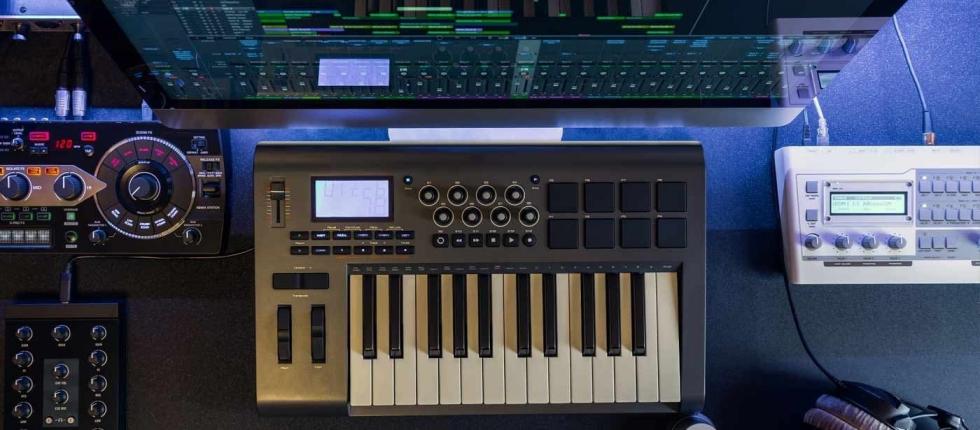Exploring Audio Mastery with Hokusai and SoundLab Audio Editors
/ by hqt
In the contemporary multimedia landscape, audio editing assumes a pivotal role, influencing auditory experiences across a wide array of domains. Whether in the realms of music production, sound design, film post-production, or podcasting, the art of precise and imaginative audio manipulation holds undeniable importance. In this exploration, we are pleased to introduce you to two distinguished audio editing tools, namely Hokusai and SoundLab Audio Editors, each distinguished by its unique capabilities, empowering creators and enthusiasts alike in their audio pursuits.

Join us as we embark on a captivating journey into the realm of audio editing, where Hokusai and SoundLab take center stage as our featured tools, enabling the mastery of audio craft across a diverse spectrum of creative domains.
Hokusai Audio Editor: A Comprehensive Examination
Features and Capabilities
Hokusai Audio Editor stands as a versatile and robust tool for audio manipulation across various platforms, providing an array of features and capabilities that render it indispensable for audio enthusiasts and professionals alike.
1) Multi-Track Editing: Hokusai empowers users to seamlessly work with multiple audio tracks concurrently, facilitating intricate audio projects and advanced mixing.
2) Foundational Editing Tools: This application equips users with fundamental audio editing tools like cutting, copying, pasting, trimming, and deletion, ensuring meticulous control over audio clips.
3) Effects and Filters: Hokusai extends a diverse selection of audio effects and filters, encompassing reverb, equalization, noise reduction, and more, enabling users to enrich and craft their audio recordings.
4) Versatile Audio Format Support: It embraces an extensive range of audio formats, simplifying the process of importing and exporting audio files in diverse formats.
5) Waveform Visualization: The visual representation of audio through waveform displays streamlines the identification of specific audio segments for precise editing.
6) Audio Recording: Hokusai facilitates direct audio recording within the application, making it an invaluable tool for capturing sounds and voiceovers on the fly.
Strengths and Distinctive Tools
1) Non-Destructive Editing: Hokusai distinguishes itself with its prowess in non-destructive editing, allowing users to make alterations to audio without permanently modifying the original file, preserving the integrity of audio recordings.
2) Advanced Automation: The application incorporates automation features that simplify repetitive tasks, such as volume adjustments or the application of effects across multiple tracks.
3) Spectral Editing: Hokusai empowers users to engage in granular-level audio manipulation through spectral editing tools, lending themselves to tasks such as noise reduction and intricate audio restoration.
4) Extensive Export Options: The software offers a comprehensive array of export options, encompassing various audio formats and quality settings, ensuring seamless compatibility with different platforms and devices.
User-Friendly Interface
Hokusai presents an intuitively designed user interface characterized by well-organized menus and controls, facilitating effortless navigation and rapid access to essential tools.
1) Optimized for Touchscreens: Its interface is thoughtfully optimized for touchscreen devices, making it accessible on mobile platforms such as smartphones and tablets.
2) Customizable Workspaces: Users benefit from the ability to tailor their workspaces to align with their preferences, affording a personalized editing experience.
Accessibility for Novices and Experts Alike
Hokusai extends a welcoming hand to beginners, offering a user-friendly interface coupled with straightforward basic editing tools, making it an ideal starting point for novices entering the realm of audio editing.
Simultaneously, Hokusai caters to seasoned audio professionals by providing advanced features and capabilities, striking a harmonious balance between simplicity and complexity to accommodate experts.
In summation, Hokusai Audio Editor offers an extensive array of audio editing features, underpinned by an intuitive interface that accommodates both novices and experts. Its utility spans music production, sound design, and diverse post-production tasks across a multitude of media formats, with its core strengths residing in non-destructive editing, spectral manipulation, and comprehensive export capabilities.
SoundLab Audio Editor: A Thorough Examination
Features and Capabilities
SoundLab Audio Editor emerges as a versatile and feature-rich tool designed for audio manipulation across diverse platforms. It presents a broad spectrum of audio editing features tailored to meet the requirements of both audio enthusiasts and professionals.
1) Multi-Track Editing: SoundLab empowers users to seamlessly handle multiple audio tracks concurrently, enabling the execution of intricate audio projects and facilitating seamless mixing.

2) Advanced Editing Tools: SoundLab equips users with an arsenal of essential audio editing tools encompassing functions such as cutting, copying, pasting, fading, time-stretching, and more. These tools ensure meticulous control over audio clips.
3) Effects and Plugins: SoundLab boasts a comprehensive library of audio effects and plugins, encompassing a wide array of options like reverb, delay, compression, and virtual instruments. This feature empowers users to sculpt and enhance their audio recordings creatively.
4) Support for Various Audio Formats: The software extends its support to a broad spectrum of audio formats, streamlining the process of importing and exporting audio files in various formats without the need for complex conversions.
5) Spectral Editing: SoundLab takes audio editing to a granular level with its spectral editing tools, enabling users to manipulate audio with precision. This feature is particularly well-suited for tasks like noise reduction, audio restoration, and innovative sound design.
Strengths and Advanced Functionalities
SoundLab distinguishes itself through its real-time collaboration capabilities, allowing multiple users to collaborate on the same audio project simultaneously. This makes it an invaluable tool for remote teamwork and project synchronization.
1) AI-Powered Audio Enhancement: Leveraging the power of artificial intelligence, SoundLab offers automated audio enhancement. It can automatically optimize audio quality, eliminate noise, and enhance recordings, significantly streamlining the editing process.
2) Customizable Macros: SoundLab empowers users to create and automate custom macros tailored to their specific needs. These macros can streamline repetitive tasks, enhancing workflow efficiency and productivity.
3) Batch Processing: The software simplifies complex post-production workflows with its support for batch processing. Users can apply effects and edits to multiple audio files concurrently, resulting in significant time savings.
User-Friendly Interface
SoundLab prides itself on its intuitive and user-friendly interface. It features well-organized menus, toolbars, and a responsive layout, ensuring a seamless and efficient editing experience.
1) Visual Waveform Display: To facilitate ease of navigation and precise editing, SoundLab provides a clear and visually informative representation of audio waveforms, allowing users to gain a better understanding of their audio content.
2) Drag-and-Drop Functionality: SoundLab streamlines the editing process with its drag-and-drop support for audio files, effects, and plugins. This intuitive feature enhances workflow flexibility and simplifies tasks.
Accessibility for Users of All Experience Levels
SoundLab goes the extra mile in supporting beginners with comprehensive tutorials and guides. These resources help newcomers get acquainted with audio editing and master the software’s features effectively.
1) Advanced User Customization: For experienced users seeking to tailor their experience, SoundLab offers advanced customization options. This includes the ability to create personalized keyboard shortcuts, custom toolbars, and workspace layouts.
In conclusion, SoundLab Audio Editor presents a comprehensive array of audio editing features and advanced functionalities, all wrapped in a user-friendly interface accessible to users of all experience levels. Its strengths lie in real-time collaboration, AI-powered enhancements, and efficient batch processing, making it an invaluable tool for music production, sound design, and post-production in various media formats.
Comparative Analysis
Strengths and Limitations of Hokusai Audio Editor
1) Strengths:
A. User-Friendly Interface: Hokusai prides itself on an intuitive and approachable interface, catering to both novices and seasoned users with ease.
B. Non-Destructive Editing: It excels at preserving the original audio quality while enabling extensive modifications, making it a reliable choice for maintaining audio integrity.
C. Spectral Editing: Hokusai’s spectral editing tools offer precision in audio manipulation, especially beneficial for tasks such as noise reduction and detailed audio restoration.
D. Multi-Track Editing: With support for multi-track editing, it becomes an apt choice for tackling intricate audio projects and seamless mixing.
E. Extensive Export Options: Hokusai ensures broad compatibility by offering a diverse array of export options, accommodating various platforms and devices.
2) Limitations:
A. Limited Advanced Features: While accessible to beginners and intermediate users, Hokusai may lack certain advanced features sought after by professional audio engineers.
B. Effect Variety: In comparison to more advanced audio editing software, the range of built-in effects and filters in Hokusai may be somewhat limited.
C. Real-Time Collaboration: Hokusai may not provide robust real-time collaboration features, potentially hindering collaborative audio projects requiring synchronized teamwork.
Strengths and Limitations of SoundLab Audio Editor
1) Strengths:
A. Real-Time Collaboration: SoundLab stands out with its real-time collaboration capabilities, fostering simultaneous work on the same audio project by multiple users—an indispensable feature for remote collaboration.
B. AI-Powered Audio Enhancement: Leveraging AI for audio enhancement streamlines the editing process by automatically enhancing audio quality and eliminating noise, simplifying post-production.
C. Customizable Macros: Empowering users to create and automate custom macros, SoundLab enhances workflow efficiency by expediting repetitive tasks.
D. Batch Processing: SoundLab’s ability to apply effects and edits to multiple audio files concurrently significantly accelerates post-production workflows.
E. Comprehensive Effects Library: SoundLab offers a wide range of effects and plugins, expanding creative possibilities for users and catering to diverse audio needs.
2) Limitations:
A. Learning Curve: The extensive feature set and advanced functionalities of SoundLab may present a steeper learning curve for beginners, requiring time and dedication to master.
B. Resource Intensive: SoundLab’s advanced features may demand substantial computational resources, potentially limiting its usage on less powerful devices.
Use-Case Scenarios for Each Tool
1) Hokusai Audio Editor:
A. Podcasting: Hokusai is well-suited for podcasters seeking a user-friendly tool to edit and enhance their audio recordings, particularly for novice podcast creators.
B. Basic Music Production: It serves as a suitable choice for musicians and hobbyists engaged in fundamental music production tasks like mixing and mastering.
C. Simple Sound Design: Hokusai can find its place in uncomplicated sound design tasks or enhancing field recordings for various projects.
2) SoundLab Audio Editor:
A. Professional Music Production: SoundLab is the go-to for professional music producers requiring advanced features, real-time collaboration, and a vast array of effects in their production work.
B. Complex Sound Design: SoundLab shines in the realm of sound design, catering to sound designers working on intricate effects for films, games, and multimedia projects.
C. Post-Production Work: It proves invaluable for post-production tasks within the film and video industry, including editing film soundtracks, conducting foley work, and automating dialogue replacement (ADR).
D. Collaborative Audio Projects: SoundLab’s real-time collaboration capabilities make it a top choice for teams engaged in remote audio projects that demand synchronized and efficient teamwork.
Above all, Hokusai Audio Editor is characterized by its user-friendly approach and suitability for basic audio needs, while SoundLab Audio Editor offers advanced features, and real-time collaboration, and is best suited for professional and collaborative audio production endeavors. The choice between the two hinges on the user’s specific requirements and level of expertise.
CONCLUSION
In summary, the realm of audio editing is brimming with possibilities, and the decision between Hokusai and SoundLab Audio Editor hinges on your specific objectives and ambitions. These two tools present a spectrum of features and limitations, each catering to diverse user profiles.
Hokusai Audio Editor shines with its user-friendly interface, adept multi-track editing capabilities, and real-time editing efficiency. It serves as an exceptional choice for those in search of a straightforward and accessible audio editing experience, especially if your primary platform is iOS.
Conversely, SoundLab Audio Editor impresses with its cross-platform adaptability, advanced audio manipulation functions, third-party plugin support, and a comprehensive sample library. It stands as an enticing option for professionals and enthusiasts eager to explore the full range of audio creativity, notwithstanding the potential learning curve and heightened resource demands.
Ultimately, the selection between Hokusai and SoundLab hinges on your project-specific demands, platform preferences, and level of expertise. Whether you’re an entry-level podcaster, an amateur musician, or an experienced sound designer, both tools empower you to craft audio experiences that align with your creative vision. Embark on your audio journey with the tool that best aligns with your distinct requirements, indulge in experimentation, and watch your auditory endeavors flourish.